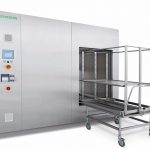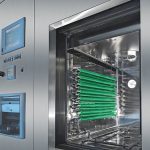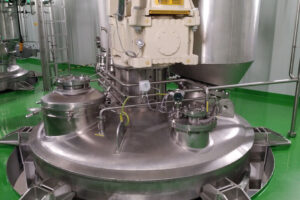Whether heparin preparations in syringes or infusion solutions in bags or bottles, all parenteral injectables place high demands on the sterility of the liquid contents. Even after filling, the process is not yet completed. Any potential microbial contaminants must be killed or inactivated. Hence the products in their final primary containers require one last step to ensure sterility: whenever feasible and depending on the active ingredients, regulatory agencies require injectable products to be terminally sterilised to ensure the safety of both product and patient by omitting all further opportunities for contamination due to human intervention.
On the primary packaging side, glass containers are resistant to the temperatures required to achieve the final sterility assurance level (SAL). While containers made of plastic are becoming increasingly attractive to pharmaceutical manufacturers, they come with quite some challenges regarding terminal sterilisation. Some are sterilised as closely as possible to the materials fusion temperature to reduce overall sterilisation times. However, some containers risk to burst, warp or lose stability during terminal sterilisation. These potential negative impacts on the product’s final validation entail long delays and additional costs for manufacturers. Hence it is vital to find the appropriate terminal sterilisation method for all drugs and containers.
In fact, the sterilisation process is among the most crucial ones in the entire drug manufacturing process, as it is responsible for ensuring patient safety. It must be controlled rigorously to make sure the product matches the intended quality, and its processes comply with both GMP requirements and sterility assurance. During the drug development process, tests identify the required sterilisation conditions for each product. Pharmaceutical manufacturers must decide on the right process for each specific drug application. The questions they need to answer are manifold.
Defining the best process
Which maximum sterilisation temperature is permissible without damaging the efficacy of temperature-sensitive drugs and containers? How long can a product remain stable between the filling and sterilisation process? What material is used for the primary packaging? What pressure conditions are needed to maintain the containers’ stability? Here, sterilisation tests help to determine each product’s processing parameters, from supporting pressure to loading procedures, thereby ensuring pharmaceutical product safety.
Terminal sterilisation is precisely tailored to pharmaceutical requirements. Depending on the medication and the approved procedure, different processes are available to maintain the containers’ integrity and to ensure the filled ingredients remain sterile and intact.
Vacuum-steam process
The vacuum-steam process is usually used to sterilise solid and porous equipment. It is also used for terminal sterilisation of closed containers like pre-filled ampoules. The remaining air is completely evacuated from the pressure vessel, making sure that saturated steam can penetrate even into the tiny cavities of porous items like plastic stoppers. The latter are subsequently heated and sterilised using pure steam. Depending on the type of load, the process finishes either with a vacuum drying or jacket cooling step. This makes vacuum steam sterilisers suitable for any pressure- and vacuum-resistant closed containers like pre-filled ampoules.
Steam/air mixture process
A process using a steam/air mixture atmosphere external to the component allows to maintain pressure equilibrium between the inner and outer environments. The steam/air mixture process is particularly suited for open, semi-sealed and completely closed containers such as vials and pre-filled sy-ringes, as well as mono- and multi-chamber bags. It makes it possible to remove products in a dry condition at the end of the cycle. The direct inflow of steam, which is circulated by fans located inside the pres-sure vessel, provides energy for heating and sterilisation, while cooling is accomplished by internal heat exchangers supplied by chilled water. Supporting pressure can be adjusted as desired, thus preventing deformation, stopper movement and container breakage throughout the entire cycle.
Hot water shower process
For larger volume containers such as IV so-lution bags, the terminal sterilisation process can also be performed using superheated water shower. As the name of the process indicates, the containers are continuously showered by circulated superheated water during the entire process. Heat exchangers in compliance with FDA requirements, which are located next to the pressure vessel, serve as energy source for the heating and cooling steps. Fast heating and cooling cycles reduce thermal load on temperature-sensitive products to a minimum. This hot water shower approach is most used for closed containers ranging across different batch sizes.
Preparing for validation
When it comes to validation, pre-tests including the essential process parameters of loading pattern, temperature, pressure, heating and cooling ramps are key. Depending on the container quantity and complexity, trial runs can take from a few hours to several days. They precisely map the sterilisation processes required by different products – and in case of doubt, they identify whether a new product or primary packaging material can be sterilised at all. Pharmaceutical and packaging manufacturers not only receive extensive documentation and practical guidance. The tests also provide them with important indications to further optimise their products and sterilisation processes.
Once a pharmaceutical manufacturer has chosen and developed the ideal sterilisation process, it must undergo validation. Depending on the nature of the solution and its propensity to microbial growth, the hold times of the solutions vary considerably and must, in certain cases, be kept to a minimum. The sterilisation temperature has to be reached and maintained in all corners of the steriliser for the afore defined timespan. At the same time, the defined pressure must be upheld. Finally, validation also includes the effectiveness of the sterilisation process, i.e. whether the desired sterility assurance level has been reached.
Existing processes re-visited
In the case of approved drugs, the required sterilisation procedure has usually already been defined. In this case, again tests can deliver valuable insights regarding the variables that need to be adjusted to achieve even more efficient processes and cycle times. The same applies to containers. Manufacturers get a detailed analysis of the container’s characteristics and potential weaknesses, resulting in important clues on how the packaging might be optimised. In case of a projected production expansion, an evaluation of the load capacities determined by comprehensive testing helps to identify the suitable size of the installation.
If the correct procedure and parameters are still to be determined, test runs can be conducted as a kind of “stress test” to answer questions regarding sterilisability and packaging quality, as well as the most suitable procedure. Manufacturers save a great amount of time and effort during qualification and validation and can accelerate the product’s market launch. Even if the test results are negative, they will certainly not lead to the cancellation of production. Instead, packaging suppliers and pharmaceutical manufacturers can target their efforts more accurately and accelerate the further development of their respective products.
Syntegon Technology GmbH, Crailsheim
Author: Thomas Ofenböck
Area Sales Manager
USA/CA/MEA, Syntegon
Author: Christian Dallner
Product Management &
Marketing, Syntegon










